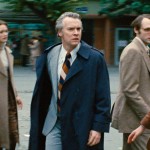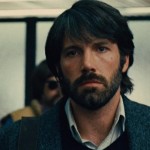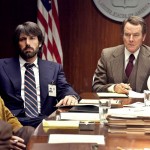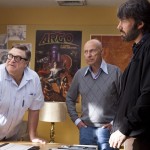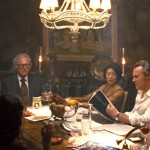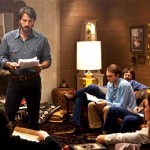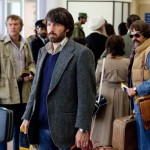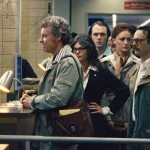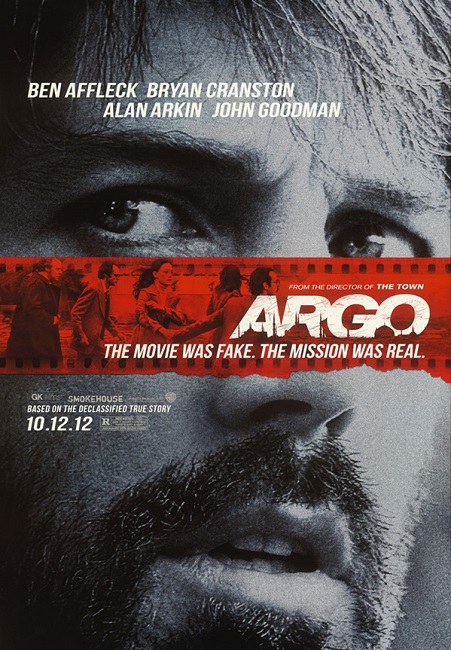
Argo – 2012
I really liked this film. The name of the game is suspense! The movie is stuffed full of intensity and nerve-wracking tension. It is so masterfully done that even though you know the ending, you are still cringing in fear for the characters. You see, it is a historical drama about an event that was all over the news. The 1979 hostage crisis in Iran was an event that shocked the world and had millions of people hoping and praying for the safety of the 55 hostages in the American Embassy in Iran.
The film starts out with a voice-over monologue along with some images drawn like story–boards for a movie, mixed in with historical photographs. The content of the voice-over was a perfect opening for the film. It is a little long, but I feel it bears repeating in its entirety here:
“This is the Persian Empire, known today as Iran. For 2,500 years this land was ruled by a series of Kings known as Shahs. In 1950 the people of Iran elected Mohammed Mosaddeq, a secular Democrat as Prime Minister. He nationalized British and U.S. petroleum holdings, returning Iran’s oil to its people. But in 1953 the U.S. and Great Brittan engineered a coup d’etat that deposed Mosaddeq and installed Reza Pahlavi as Shah. The young Shah was known for opulence and excess. His wife was rumored to bathe in milk, while the Shah had his lunches flown in by Concord from Paris. The people starved. The Shah kept power through his ruthless internal police the SAVAK. An era of torture and fear began. He then began a campaign to westernize Iran, enraging a mostly traditional Shiite population. In 1979 the people of Iran overthrew the Shah. The exiled cleric Ayatollah Khamenei returned to rule in Iran. He descended into score-settling, death squads and chaos. Dying of cancer, the Shah was given asylum in the U.S. The Iranian people took to the streets outside the U.S. Embassy, demanding that the Shah be returned, tried and hanged.”
Interesting note: There is a slight inaccuracy in that opening narration. Pahlavi was already the Shah when the coup d’etat took place. In fact, it was he who dismissed Mosaddeq to begin the coup. But enough of the history lesson.
The film then concentrates on the 6 individuals who escaped the U.S. Embassy and hid in the residence of the Canadian Ambassador in Iran, Ken Taylor, played by Victor Garber. Tony Mendez, played by Ben Affleck is the C.I.A. operative who conceives of a rescue plan and is sent in to get them out.
The plan is to fabricate a science-fiction film from Hollywood called Argo. Then Mendez would go to Iran, claiming to be a Canadian filmmaker scouting for filming locations. He would meet with the 6 escapees and give them the identities of a film crew, then fly out with them using fake passports issued by Canada.
Now, I’m going to say right up-front, when this movie first came out, one of the biggest complaints was that it ignored the 52 hostages that were held in the Embassy for 444 days. Let me dispel that argument right now. First of all, the movie wasn’t about them. It was about the 6 who got out. Why would it focus at all on the 52? And second, the rest of them were mentioned several times! Their fate was divulged in the little blurbs at the end of the movie, telling what happened to the characters. Attention was paid! If the movie were about them, it would have spent considerably more time on their terrifying situation.
Ben Affleck actually did a good job. Somehow he has earned himself a bit of a reputation in Hollywood as a bad actor, probably in association with a movie called Gili, widely considered one of the worst films ever made. But this was a role in which he seemed very comfortable. He grew a beard for the role and it looked good on him. I thought he really did a good job and had no complaints about his performance. The only thing I will say is that it was part of his character to keep his emotions suppressed in the interest of keeping everyone calm, so he didn’t have to stretch himself as much as other characters in that respect.
Bryan Cranston played his boss at the C.I.A., Jack O’Donnell. Cranston did a fantastic job. It would have been so easy to make the character the stereotypical hard-nosed boss without much depth. But Cranston brought a measure of humanity and humor to the role that was refreshing.
John Goodman and Alan Arkin played John Chambers and Lester Siegel, a Hollywood make-up artist and a film producer, both of whom were in on the plan. They did everything you would have to do to get a movie produced. They got the rights to the script, started an advertisement campaign, went through casting calls, did a publicized reading, had posters made up, and drew up story-boards, all the while knowing that the movie itself was a complete fake with the sole purpose of retrieving the 6 American citizens hiding in Iran.
Interesting note: According to Tony Mendez, the fake production office known as Studio Six was so convincing in the real-life Argo plan that even several weeks after it folded and the Iranian rescue was complete, “we had received twenty-six scripts. One was from Stephen Spielberg.”
Where the film’s masterfully crafted tension cam in is that we learn that there is a race of sorts going on. The American diplomats had shredded as many of their files as they could so that they wouldn’t fall into the hands of their captors. The Iranians had sweat-shop children going through basket after basket of shredded paper, reconstructing the personnel files to find out whether there were any Americans that they were not holding as hostages. The rescue plan had to be executed before the identities of the 6 escapees could be determined.
The tension was slowly built throughout the entire film. Even though the outcome was just a matter of history that anyone who lived through that crisis would already know, the climax of the movie was exciting and made by heart race. Several of the details were altered, maybe a time line or two sped up or slowed down to make the final escape one that was close cut and nerve-wracking.
Interesting note: Apparently the 6 diplomats were not in as much danger as the movie depicts, though that was another detail that the Hollywood movie machine played up, despite reality. Not the first time, and certainly not the last time that has happened.
The 6 Americans trying to escape Iran were, for the most part, fairly unknown actors, with one exception. Tate Donovan played the part of Robert Anders. He served as the leader of the group of diplomats. In addition, actors Clea DuVall, Christopher Denham, Scoot McNairy, Kerry Bishe and Rory Cochrane played the rest of the diplomats. I mention their names because they each brought a different dynamic to the group.
Most notably, McNairy’s character, Joe Stafford was the man who created even more tension, being too afraid to participate in the escape plan. He also carried a bit of the film’s emotional content, confessing that he felt certain that they would all die.
Now, one of the most amazing parts of the movie was the fact that, in regards to casting and make-up, special attention was given to the look of each character. They went out of their way to make the actors look like the real people who were involved in the events depicted in the movie. And they really did a great job. In fact, at the end of the movie, they made a point of showing the actors along-side historical archive photos of the people they were portraying. The likenesses were remarkably similar. In fact, I believe the only three main actors who this did not happen for were Affleck, Arkin and Cranston.
As I usually do when dealing with a historical drama, I must take a quick look at any glaring historical inaccuracies. Small ones are forgivable, but big ones have to be at least mentioned. Of course, Argo is only loosely based on the Iran Hostage Crisis. The character of John Sheardown and his wife were completely left out of the movie. Sheardowns was a Canadian Immigration Official, at whose residence several of the American Diplomats stayed. In the film, they all stayed together at the Taylor residence.
Another inaccuracy that should be noted is the fact that the movie makes a point of saying that when the 6 diplomats were on the run, they went to both the British Embassy and the New Zealand Embassy looking for asylum, but both countries turned them away. This is completely untrue. In fact, they spent one night with the Brits before moving to the safer location with the Canadians. The New Zealanders actually drove the 6 diplomats to the airport on the day of their departure.
In reality, there was no real tension at all. There was no great race to leave the country. There were no problems getting past guards at the airport. There were no police cars chasing the airplane down the runway. The whole rescue operation was not very nearly cancelled at any point. But hey, this is Hollywood. Hollywood is rarely in the business of telling the absolute truth. It is a filmmaker’s job to entertain an audience using all the tools at their disposal such as dramatic and emotional tension, suspense, and intrigue. If they had strictly stuck to reality, it would have been too dull a story to warrant a movie at all.
And finally, there is one last inaccuracy that I need to mention. The movie implies that the entire rescue operation was planned and executed by the C.I.A., but it was really the Canadians, working with Tony Mendez, who apparently did 90% of the planning, organizing, and execution of the rescue. The biggest thanks of all should have gone to Ken Taylor and the Canadians who orchestrated most of the operation.
But like I said, this is Hollywood. The movie was full of suspense and was exciting to watch. So, it did its job, and did it well. This is definitely a movie that deserved the Oscar for Best Picture.
